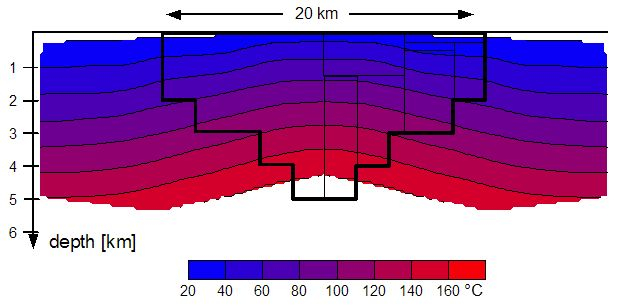It is not surprising that impact structures as anomalous geophysical bodies may significantly influence also the earth’s normal geothermal field. The in part strong modification of rocks in the impact cratering process affects the thermal conductivity as the decisive petrophysical parameter related with heat flow density and temperature field. However, geothermics has never played a major role in the investigation of impact structure as is the general case in applied geophysics. This may be explained by the difficulty to obtain lots of data as a base for model calculations and quantitative interpretations. With the increasing interest in the exploitation of geothermal energy and in underground heat and cold storage, however, geothermics has more and more attracted attention obviously with some benefit also for the investigation of impact structures. As an example, a study
Henkel, H., Bäckström, A., Bergman, B., Stephansson, O., Lindström, M. (2005): Geothermal energy from impact craters? The Björkö case. Proceedings of the World Geothermal Congress 2005 paper 0667, 5 pp.
Projects of geothermal investigations in the Chicxulub and Chesapeake impact structures are stated. An early study of the geothermal situation in an impact structure has been published for the Ries crater in Germany: Hänel, R. and Bram, K. (1977): The geothermal field of the Ries crater area, – Geologica Bavarica, 75, 373-380 (in German). From boreholes in the crater area, temperature and a few thermal conductivity data were obtained for heat flow density determinations and the calculation of a simple geothermal model of cylindrical symmetry (Fig. 1) adapted to a density model from gravity measurements (Ernstson and Pohl 1977).
 Fig. 1. Cylindrically symmetric geothermal model of the Ries crater (modified from Hänel and Bram, 1977). The subdivision of the model body into cylindrical rings of rectangular cross section is adapted to a gravity model.
Fig. 1. Cylindrically symmetric geothermal model of the Ries crater (modified from Hänel and Bram, 1977). The subdivision of the model body into cylindrical rings of rectangular cross section is adapted to a gravity model.
The central rise of the isotherms in this crater model is ascribed to low thermal conductivities. In a more recent study Geothermal characteristics of the Ries impact structure
by Yu. Popov, J. Pohl, R. Romushkevich, V. Tertychnyi and H. Soffel; abstract:http://www.ingentaconnect.com/content/bsc/gji/2003/00000154/00000002/art00006?crawler=true
based on new thermal conductivity measurements of cores from the Ries 1973 deep drill hole, the authors suggest to modify the early results, and a significant increase of the heat flow density in the upper part of the structure is ascribed to fluid migration from deeper parts. The correlation of the measured thermal conductivity data with other petrophysical data derived from well logging suggests a prediction of rock physical properties from thermal conductivity values. According to the authors, impact structures may generally be characterized by the absence of thermal anisotropy in crystalline rocks, increasing thermal conductivity with depth and increasing heat flow density.






































































